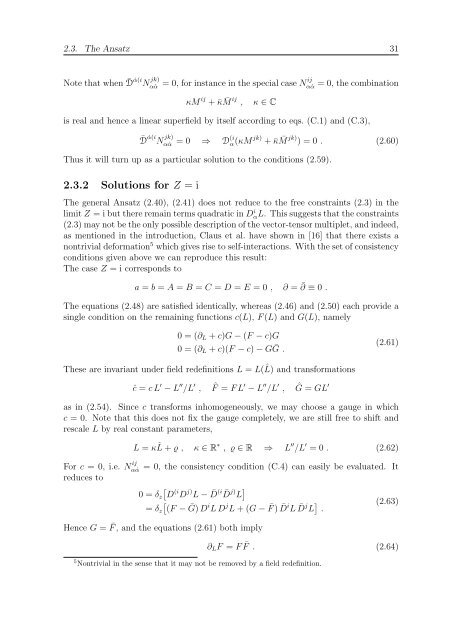N=2 Supersymmetric Gauge Theories with Nonpolynomial Interactions
N=2 Supersymmetric Gauge Theories with Nonpolynomial Interactions
N=2 Supersymmetric Gauge Theories with Nonpolynomial Interactions
You also want an ePaper? Increase the reach of your titles
YUMPU automatically turns print PDFs into web optimized ePapers that Google loves.
2.3. The Ansatz 31<br />
Note that when ¯ D ˙α(i N jk)<br />
α ˙α<br />
ij<br />
= 0, for instance in the special case Nα ˙α = 0, the combination<br />
κM ij + ¯κ ¯ M ij , κ ∈ C<br />
is real and hence a linear superfield by itself according to eqs. (C.1) and (C.3),<br />
¯D ˙α(i N jk)<br />
α ˙α<br />
= 0 ⇒ D(i α(κM jk) + ¯κ ¯ M jk) ) = 0 . (2.60)<br />
Thus it will turn up as a particular solution to the conditions (2.59).<br />
2.3.2 Solutions for Z = i<br />
The general Ansatz (2.40), (2.41) does not reduce to the free constraints (2.3) in the<br />
limit Z = i but there remain terms quadratic in D i αL. This suggests that the constraints<br />
(2.3) may not be the only possible description of the vector-tensor multiplet, and indeed,<br />
as mentioned in the introduction, Claus et al. have shown in [16] that there exists a<br />
nontrivial deformation 5 which gives rise to self-interactions. With the set of consistency<br />
conditions given above we can reproduce this result:<br />
The case Z = i corresponds to<br />
a = b = A = B = C = D = E = 0 , ∂ = ¯ ∂ ≡ 0 .<br />
The equations (2.48) are satisfied identically, whereas (2.46) and (2.50) each provide a<br />
single condition on the remaining functions c(L), F (L) and G(L), namely<br />
0 = (∂L + c)G − (F − c)G<br />
0 = (∂L + c)(F − c) − G ¯ G .<br />
These are invariant under field redefinitions L = L( ˆ L) and transformations<br />
ĉ = c L ′ − L ′′ /L ′ , ˆ F = F L ′ − L ′′ /L ′ , ˆ G = GL ′<br />
(2.61)<br />
as in (2.54). Since c transforms inhomogeneously, we may choose a gauge in which<br />
c = 0. Note that this does not fix the gauge completely, we are still free to shift and<br />
rescale L by real constant parameters,<br />
For c = 0, i.e. N ij<br />
α ˙α<br />
reduces to<br />
L = κ ˆ L + ϱ , κ ∈ R ∗ , ϱ ∈ R ⇒ L ′′ /L ′ = 0 . (2.62)<br />
= 0, the consistency condition (C.4) can easily be evaluated. It<br />
<br />
(i j)<br />
0 = δz D D L − D ¯ (i<br />
D¯ j)<br />
L<br />
<br />
= δz (F − G) ¯ i j<br />
D L D L + (G − F ¯) D¯ i<br />
L D¯ j<br />
L .<br />
Hence G = ¯ F , and the equations (2.61) both imply<br />
(2.63)<br />
∂LF = F ¯ F . (2.64)<br />
5 Nontrivial in the sense that it may not be removed by a field redefinition.

















